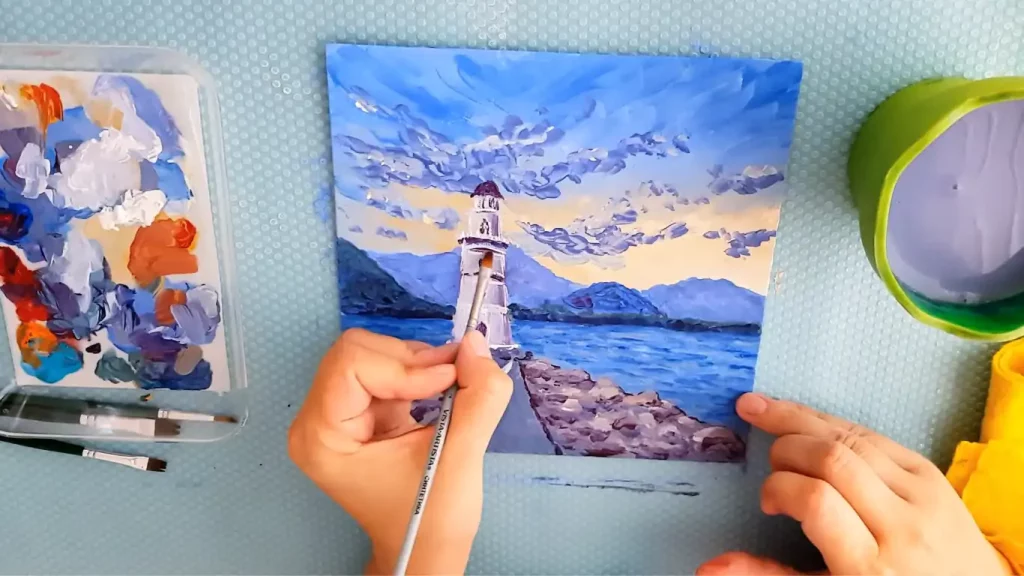If you’re an artist, or even if you just like to dabble in painting from time to time, you’ve probably heard of both Oil paint and Tempera paint. But what’s the difference between the two? And more importantly, what are the benefits of oil paint vs Tempera paint?
In this article, we will compare the two mediums and their benefits to help you decide which is right for your next painting project.
The main benefits of oil paint are that oil paint is known for its rich, vibrant colors and smooth texture. It dries slowly, giving the artist time to work with the paint and create subtle blending effects. Oil paint is also very durable, making it ideal for paintings that will be on display for long periods. And the main benefits of tempera paint are that it is a water-based medium that dries quickly and is also non-toxic. This makes it perfect for projects that need to be completed in a short amount of time.

Benefits of Oil paint vs Tempera Paint
Oil paint and tempera paint are two popular types of painting mediums. Each has its own unique set of benefits that make it ideal for certain projects. Let’s have a look at the benefits of each type of paint.
Benefits of Oil paint:
- Time: Oil paint dries slowly, which allows the artist to work on a painting for longer before it needs to be varnished or framed. As it dries slowly, you can make changes if there is a mistake.
- Flexibility: There are many advantages to using oil paint, but the main advantage is its flexibility. Oil paint can be thinned down with solvents or thickened with mediums, giving the artist much control over the final result.
- Color Depth: Rich colors: Because oil paints are slow-drying, they allow for more pigment to be used in each color. This results in richer, more saturated colors than tempera paints. Oil paint also has a rich, luminous quality that can’t be achieved with other types of paints.
- Smooth texture: Oil paints dry slowly, so they have a chance to level out as they dry. This gives them a smoother texture than tempera paints, which can often be chalky or grainy.
- Consistency: The best benefit of using oil paint is that it doesn’t change the color or finish once used. So, you can always predict what your art piece will look like after you finish painting.
- Increased durability: Once oil paintings are fully dry (which can take months), they become quite durable and resistant to damage.
Benefits of Tempera paint
Time: If you want your paintings to dry fast, then you can use Tempera paints. It dries quickly, which is ideal for projects that need to be completed quickly. It can be thinned with water if necessary.
Versatility: The versatility of Tempera paint is another unique benefit of it. Tempera paint can be used on various surfaces, including wood, glass, and fabric. Even you can use it on your hair if you want. You don’t need any special solvents or extra material.
Durability: Tempera paint has better durability. It can withstand humidity and temperature and also doesn’t fade over time. It also retains its shade and vibrancy. Unlike oil paint, it doesn’t turn yellow after a long period of time. Tempera paint is also less likely to chip or fade over time than oil paint, making it a good choice for paintings that will be hung in high-traffic areas or exposed to direct sunlight.
Shrink-Resistance: Tempera paint doesn’t shrink; rather, it retains its shape, and unlike oil paint, it doesn’t change its volume over time.
Compatibility and Safe: Tempera paint is water-based, so you can mix it with other water-based paints such as acrylic and gouache colors. Also, tempera paint is non-toxic, and there are no allergens in it.
Budget-friendly: Another advantage of tempera paint is that: Tempera paint is very inexpensive. It is easy to find, as it is sold in most craft stores.

Is Tempera Paint Better Than Oil Paint?
There are a few things to consider when trying to decide if Tempera or oil is the better medium. It really depends on the project and what you are trying to achieve. Here are a few things to think about:
Drying time: Tempera paint dries much faster than oil paint, so if you need something that will dry quickly, Tempera is the way to go. Oil paint can take days or even weeks to dry fully.
Texture: Tempera paint is generally smoother and more consistent than oil paint. If you want a very smooth finish, Tempera is probably your best bet. However, some artists prefer the textured look of oil paint.
Opacity: Tempera is more opaque than oil, so it can be helpful for covering up mistakes or dark colors. However, if you want your painting to have a transparent look, oil would be a better choice. So overall, there are pros and cons to both tempera and oil paints.
Tempera Paint vs Oil Paint
Oil paints and tempera paints are both commonly used for creating art. They each have their own unique properties that can affect the way the paint behaves and the final result. Here is a detailed breakdown of how these two types of paints differ:
Oil Paints:
- Oil paints are made by combining pigments with a drying oil, such as linseed oil.
- They have a thick, creamy consistency and can take longer to dry than tempera paints.
- Once dry, they are very durable and won’t crack or flake off as tempera paintings can.
- Oil paintings usually have a more glossy finish than tempera paintings.

Tempera Paints:
- Tempera paints are made by mixing pigments with a water-soluble binder, such as calcium carbonate, starch, or cellulose. They have a thinner consistency than oil paints and will dry much more quickly.
- However, they are not as durable as oil paintings and may crack or flake over time if not properly sealed.
- Tempera paintings often have a matte finish. But you can make it shiny manually if you want.
Oil paints and tempera paints have several key differences. Why do oil paints take much longer to dry than tempera paints? This is because the pigments in oil paints are suspended in an oil medium, whereas the pigments in tempera paints are suspended in a water-based medium.
Because of this difference, oil paintings can take weeks or even months to fully cure, while tempera paintings will be dry to the touch within a few hours. Another difference between these two types of paint is that oil paint is more forgiving when it comes to mistakes. Since it dries slowly, you have ample time to correct any errors before the paint sets permanently.
Tempera paint, on the other hand, dries quickly and is less forgiving of mistakes. Once it’s set, there’s no going back! Finally, oil painting produces a richer, more vibrant color than tempera painting.
This is due to the fact that pigments mixed with an oil base tend to be more concentrated than those mixed with a water base. As such, you’ll need to use less oil paint than tempera paint to achieve your desired results.
What Are the Disadvantages of Oil Painting?
If the drying time of oil paint is a benefit for some artists, it can be a drawback for some others. If you want your paint to dry fast for your projects, then oil paint won’t be your first choice. Plus, you need to take care of the paintings so that the wet surface doesn’t come in contact with any harmful things that can damage the painting.
Another disadvantage of oil paint is its acute odor which some find offensive.
The most popular oil paint, such as Linseed oil paint, becomes dark or yellow over time.
One disadvantage of oil painting is that it can be difficult to achieve certain colors. For example, if you want to paint a light blue sky, it can be hard to get the right shade using only oil paint. You may need to add other colors or mediums to your palette in order to create the perfect color for your painting.
What are the disadvantages of Tempera Painting?
Tempera paints dry very fast. Some artists don’t like the fast-drying nature of tempera paints because if they make any mistake, there is no room for improvement.
The main disadvantage of tempera paint is that it needs to be applied in thin layers. As a result, it doesn’t attain the deep and versatile color as oil paint does. It doesn’t provide as much precision as oil paint does.
Some artists don’t like the chalky finish of Tempera paints. Tempera paint provides a matt finish that lacks a glossy finish. But you can use make the paint shiny if you want.
What is the Preferred Ground for Egg Tempera Paint?
Egg tempera is a paint made from eggs and pigment. It is water-soluble and dries quickly, making it ideal for painting on wood, stone, or metal. The preferred ground for egg tempera is gesso, which is a mixture of plaster and glue.
Egg tempera can also be used on canvas, but it will not adhere as well and may crack over time.
How is Tempera Paint Made?
Tempera paint is a type of paint that has been around for centuries. It is made from a variety of ingredients, including egg yolks, flour, water, and sometimes oil. The paint is usually mixed by hand, using a wooden spoon or spatula.
The first step in making tempera paint is to whisk the egg yolks and water together until they are light and frothy. Then, the flour is slowly added to the mixture while continuing to whisk. Once all of the flour has been incorporated, the resulting mixture should be thick and smooth.
If desired, oil can be added to the Tempera paint at this point. This will help to make the paint more opaque and give it a glossy finish. Once everything is combined, the tempera paint is ready to use!
To store unused Tempera paint, simply place it in an airtight container and keep it in a cool, dark place. It can typically last for several months if stored properly.
It really depends on your project and what you’re looking for in terms of results. If you want bright, bold colors, go with oil paint. If you need to work quickly or want a thinner consistency, go with acrylics.
Conclusion
Oil paint and tempera paint are both popular choices for artists, but they have different benefits. Oil paint is known for its rich colors and smooth texture, while Tempera paint is cheaper and easier to clean up.

S. Pushon is a paint expert, self-taught artist, and currently working as an adviser in the paint industry as a Quality Improvement and Development Assistant.
An artist by heart, he draws remarkable art pieces and as a professional paint industry individual, he seeks the insight and shares with enthusiasts. Read more…

